Elevating Characters Through High Fashion: A Writer's Guide to Style Storytelling
- Grahame Peace
- 2 days ago
- 3 min read
Fashion is more than just clothing. For writers, it serves as a powerful tool to reveal character traits, social status, and emotional states. When used thoughtfully, high fashion can bring characters to life, making them vivid and memorable. This explores how I weave style into storytelling, helping me to create richer, more engaging narratives.

Why Fashion Matters in Character Development
Clothing choices reflect personality, background, and mood. A character’s style can hint at their ambitions, insecurities, or cultural influences without explicitly stating them. For example, a protagonist who wears bold, avant-garde pieces might be confident and daring, while another who opts for classic, understated garments could be more reserved or traditional.
Fashion also sets the tone for scenes and relationships. A character’s outfit can create tension, signal transformation, or deepen conflict. Writers who master this craft add layers to their stories, making readers feel closer to the characters.
Understanding Your Character’s Style
Before describing fashion, understand who your character is:
Personality: Are they rebellious, elegant, quirky, or pragmatic? Their style should reflect these traits.
Background: Consider their culture, upbringing, and social class. A character from a wealthy family might favour designer labels, while someone from a modest background might mix high fashion with thrifted finds.
Occupation and Lifestyle: A fashion designer’s wardrobe differs greatly from a corporate lawyer’s. Their daily life influences their clothing choices.
Emotional State: Clothing can mirror mood. A character dressed in dark, structured pieces might be feeling guarded or serious, while flowing, colourful fabrics could indicate joy or freedom.
Using Fashion to Show Character Growth
Fashion can track a character’s journey. Changes in style often parallel internal shifts:
A shy character might start with simple, neutral clothes and gradually embrace bold colours as they gain confidence.
Someone recovering from trauma might initially wear loose, concealing garments and later choose more form-fitting, expressive outfits.
A character climbing the social ladder may adopt more polished, expensive looks to fit in.
These visual cues help readers follow development without heavy exposition.
Describing Fashion with Precision and Purpose
Avoid vague descriptions like “she wore a nice dress.” Instead, focus on details that reveal character or mood:
Fabric texture: silk, velvet, denim, leather
Colour and pattern: crimson, pastel, floral, geometric
Fit and silhouette: tailored, oversized, flowing, structured
Accessories: statement necklace, vintage brooch, designer handbag
For example, instead of “He wore a suit,” try “He donned a sharply tailored navy blazer with a crisp white shirt, the kind that whispered power and precision.”
Incorporating Fashion into Dialogue and Action
Fashion can come alive through interactions:
Characters might comment on each other’s outfits, revealing opinions or relationships.
A character adjusting their cufflinks or smoothing a skirt can show nervousness or pride.
Fashion mishaps, like a torn seam or scuffed shoe, add realism and tension.
These moments make style part of the story’s fabric rather than just background.
Examples from Literature and Film
Many great storytellers use fashion to deepen characters:
Gatsby’s suits in The Great Gatsby symbolise wealth and the desire to impress.
Carrie Bradshaw’s eclectic wardrobe in Sex and the City reflects her bold personality and evolving identity.
Miranda Priestly’s impeccable style in The Devil Wears Prada underscores her authority and exacting standards.
Studying these examples can inspire writers to use fashion more effectively.
Practical Tips for Writers
Research current and historical fashion trends relevant to your story’s setting.
Use fashion magazines, runway shows, and designer profiles for inspiration.
Avoid clichés like “little black dress” unless you add a unique twist.
Balance description with story flow; don’t let fashion overwhelm the plot.
Consider how fashion interacts with setting, culture, and character goals.










Comments